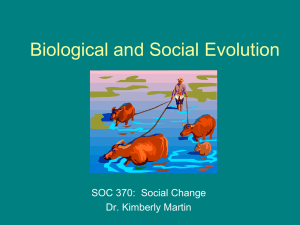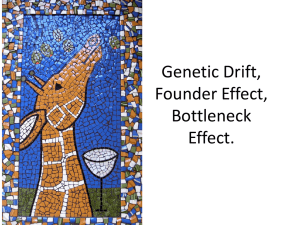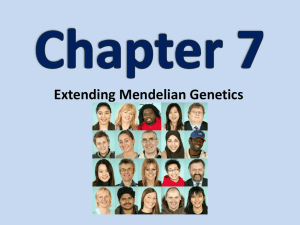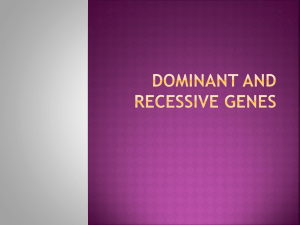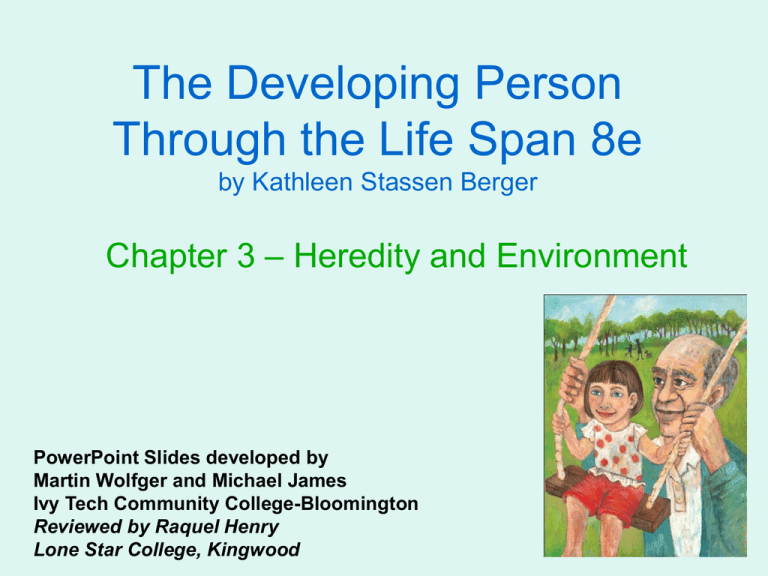
The Developing Person
Through the Life Span 8e
by Kathleen Stassen Berger
Chapter 3 – Heredity and Environment
PowerPoint Slides developed by
Martin Wolfger and Michael James
Ivy Tech Community College-Bloomington
Reviewed by Raquel Henry
Lone Star College, Kingwood
The Genetic Code
What Genes Are
DNA (deoxyribonucleic acid)
• Molecule that contains the chemical instructions
for cells to manufacture various proteins
• Promotes growth and sustains life
What Genes Are
Chromosomes:
• Molecules of DNA
• DNA consists of 46 chromosomes arranged in
23 pairs
What Genes Are
Genes
• Specific sections of a chromosome carry
instructions via four chemicals.
• Chemicals organized in four pairs (A-T, T-A,
C-G, G-C).
• Each person has about 3 billion pairs.
What Genes Are
Allele
• A variation that makes a gene different in some
way from other genes for the same
characteristics
• Many genes never vary; others have several
possible alleles
Genome
• The full set of genes that are the instructions to
make an individual member of a certain species
The Beginnings of Life
Gametes
• Reproductive cells (sperm and ova)
• Each consists of 23 chromosomes.
Zygote
• Two gametes (sperm and ovum) combine
and produce a new individual with 23
chromosomes from each parent.
The Beginnings of Life
Matching Genes
Genes are passed down from
generation to generation
Genotype
• An organism’s genetic
inheritance, or genetic potential
• Unique for each organism
Matching Genes
Homozygous
• Two genes of one pair that are exactly the
same in every letter of their code.
Heterozygous
• Two genes of one pair that differ in some way.
• Typically one allele has only a few base pairs
that differ from the other member of the pair.
Male or Female?
• Humans usually possess 46
chromosomes.
– 44 autosomes and 2 sex chromosomes
termed the 23rd pair
– Females: XX
– Males: XY
– Sex of offspring depends on whether the
father’s Y sperm or X sperm fertilizes the
ovum.
Male and Female
The Beginnings of Life
• The zygote begins duplication and division
then differentiation and specialization
occur.
• Cells change from being stem cells, those
from which any other specialized type of
cell can form, to being only one kind of
cell.
Twins
Monozygotic (identical) twins
• Originate from one zygote that splits very
early in development
• Same genotype
Dizygotic (fraternal) twins
•
Result from fertilization of two separate ova
•
by two separate sperm
•
Incidence is genetic and varies by ethnicity
•
and age.
Assisted Reproduction
Assisted reproductive technology (ART)
• a general term for the techniques that help
infertile couples conceive and sustain a
pregnancy
In vitro fertilization (IVF)
• takes place outside a woman’s body
• involves mixing sperm with ova surgically
removed from the woman’s ovary
• if a zygote is produced, it is inserted into a
woman’s uterus, where it may implant and
develop into a baby.
From One Cell to Many
Phenotype
• The observable characteristics of a person,
including appearance personality, intelligence,
and all other traits
• Intimately connected with genotype
Almost every trait is:
• polygenic (affected by many genes)
• multifactorial (influenced by many factors)
Epigenetics
• Referring to environmental factors that
affect genes and genetic expression
Gene-Gene Interactions
Human Genome Project
• International effort to map the complete
human genetic code
• Essentially completed in 2001; analysis is
ongoing
• Found “only” about 20,000 genes in humans
• Exact number is unknown
Additive Heredity
Additive genes
• Genes that add something to some aspect of
the phenotype
• Effects of additive genes add up to make the
phenotype
• Example: Height is affected by the
contributions of about 100 genes
Dominant-Recessive Heredity
• Dominant-recessive pattern - Dominant
gene is more influential than the recessive
gene (non-additive).
– Dominant gene can completely control the
phenotype with no noticeable effect of
recessive gene.
– Genes for blood type B and Rh-positive blood
are dominant.
Dominant-Recessive Heredity
• Carrier: a person whose genotype
includes a gene that is not expressed in
the phenotype
– Unexpressed gene occurs in half of the
carrier’s gametes and is passed on to half of
the carrier’s offspring
– Offspring can be carrier or express the gene
in the phenotype (e.g. when unexpressed
gene is inherited by both parents)
Dominant-Recessive Heredity
• X-linked: A gene carried on the x chromosome
Alcoholism
• Alcoholism probably has a genetic basis
– Genes can cause an overpowering addictive
pull in some people
– Environmental conditions can modify the
genetic effects
– Nature and nurture combine to create an
alcoholic
Nearsightedness
• Termed myopia
• Low nearsightedness runs in
families and is associated with
minor variations in the Pax6
gene
• Environment also plays a role
– Increase in nearsightedness
among East Asian schoolchildren
– Increased schoolwork may have
caused nearsightedness in
children with a Pax6 allelle
Heritability
• Statistical term that indicates what portion
of the variation in a particular trait within a
particular population is inherited.
– Example: 90% of the height differences
among children of the same age is genetic.
• Environment can affect the expression of
inherited genes.
Not Exactly 46
Down Syndrome (Trisomy-21)
–
–
–
–
–
Three copies of chromosome 21
Specific facial characteristics (thick
tongue, round face, slanted eyes)
Hearing losses, heart abnormalities,
muscle weakness, short stature
Slow to develop language
Accelerated aging (cataracts,
dementia, certain forms of cancer
common at age 40)
Gene Disorders
a) Dominant-Gene Disorders
•
•
•
•
Half of the offspring of parents with a dominant
disorder will have the disorder.
Most dominant disorders begin in adulthood (fatal
dominant childhood conditions cannot be passed
on).
Many dominant disorders have relatively mild or
variable symptoms.
Tourette syndrome
– Some who inherit the dominant gene exhibit
uncontrollable tics and explosive outbursts
– Most have milder, barely noticeable symptoms
Gene Disorders
b) Recessive Disorders
•
Fragile X syndrome
– Most common form of inherited mental retardation
– Additional symptoms include muscle weakness,
shyness, and poor social skills
•
Sickle-cell trait
–
–
Offers some protection against malaria
African carriers are more likely than non-carriers to
survive
Genetic Problems
Genetic Counseling and Testing
Genetic Counseling
•
•
Consultation and testing by trained professionals
Enables prospective parents to learn about their
genetic heritage, including harmful conditions that
may be passed on to their offspring
Ethical Guidelines
•
•
Test results are kept confidential
Decisions regarding sterilization, adoption, abortion,
or carrying a pregnancy to term are made by the
clients
Genetic Counseling and Testing
Phenylketonuria (PKU)
• Recessive condition
• Results in inability to metabolize
phenylalanine (amino acid found in many
foods)
• Buildup of phenylalanine causes brain
damage, progressive mental retardation, and
other symptoms
• Early testing and a special diet usually results
in normal development





